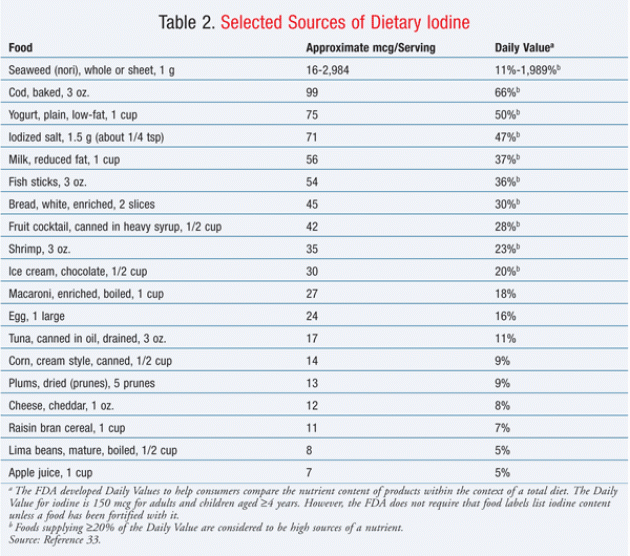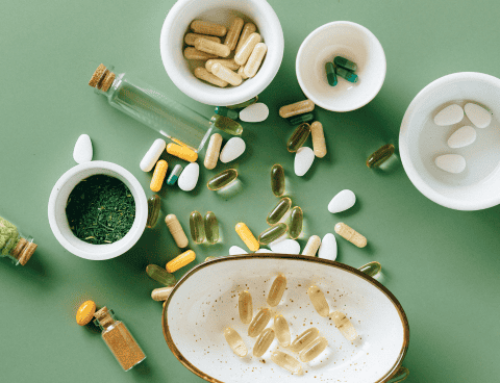Iodine: An Overlooked Essential Mineral for Female Athletes
Calcium, iron and zinc get the most recognition as vitamins and minerals necessary for female athletes to include in their diets. However, don’t overlook iodine. It is equally essential.
What Is Iodine?
Iodine acts as an antioxidant in your body, regulating the thyroid gland. Without adequate iodine levels, the thyroid progressively enlarges in an effort to absorb more iodine from the bloodstream. This can lead to development of a goiter, an enlargement of the thyroid gland and a huge indicator of iodine deficiency.
Other symptoms of iodine deficiency include:
- Fatigue/weakness
- Constipation
- Depression
- Dry skin
- Brittle nails
- Unintended weight gain
Iodine deficiency is diagnosed across populations and not specifically in individuals. Since iodine is released from the body through the urine, the best way to determine iodine deficiency across a large population is to measure amounts of iodine in urine samples.
Who’s at Risk?
Athletes are at higher risk for iodine deficiency since it’s also lost through sweat. Although replacing iodine is critical for everyone, athletes in particular need to replace iodine, because it aids in hormonal regulation and the release of cortisol during times of stress. Iodine also aids in:
- Regulating hunger and preventing cravings
- Stabilizing metabolism
- Allowing for the energy from food to be converted into cells
Proper iodine levels result in greater focus, better sleep, and better dietary choices, all of which are critical for athletes.
The Struggle for Female Athletes
Women in particular need to monitor iodine intake, because it encourages the body to maintain a healthy estrogen balance. Iodine is highly concentrated in the breasts, where bromide and fluoride compete for absorption. Contamination of these two minerals has been associated with breast cancer in women and may also be associated with fibrocystic breast disease, which although not harmful does cause lumpy, painful breasts.
How Much Iodine You Need and How to Get It
The recommendation for females ages 14 years and older is 150 mcg/day. Iodine is rich in various soils, and deficiencies commonly occur in regions that lack this soil. Plants grown in this soil contain iodine. Deficiencies are also common for people who do not use iodized table salt, which is the main food source of iodine. Other food sources include:
A new trend is seaweed chips, which are sold in many health food stores. This is a fun, easy way to get iodine if you are interested!
Sources
- http://iodine4health.com/ortho/abraham_ortho.htm
- http://www.positivehealth.com/article/nutrition/iodine-the-forgotten-nutrient
- http://www.thyroid.org/
- http://ods.od.nih.gov/factsheets/Iodine-HealthProfessional/
RECOMMENDED FOR YOU
MOST POPULAR
Iodine: An Overlooked Essential Mineral for Female Athletes
Calcium, iron and zinc get the most recognition as vitamins and minerals necessary for female athletes to include in their diets. However, don’t overlook iodine. It is equally essential.
What Is Iodine?
Iodine acts as an antioxidant in your body, regulating the thyroid gland. Without adequate iodine levels, the thyroid progressively enlarges in an effort to absorb more iodine from the bloodstream. This can lead to development of a goiter, an enlargement of the thyroid gland and a huge indicator of iodine deficiency.
Other symptoms of iodine deficiency include:
- Fatigue/weakness
- Constipation
- Depression
- Dry skin
- Brittle nails
- Unintended weight gain
Iodine deficiency is diagnosed across populations and not specifically in individuals. Since iodine is released from the body through the urine, the best way to determine iodine deficiency across a large population is to measure amounts of iodine in urine samples.
Who’s at Risk?
Athletes are at higher risk for iodine deficiency since it’s also lost through sweat. Although replacing iodine is critical for everyone, athletes in particular need to replace iodine, because it aids in hormonal regulation and the release of cortisol during times of stress. Iodine also aids in:
- Regulating hunger and preventing cravings
- Stabilizing metabolism
- Allowing for the energy from food to be converted into cells
Proper iodine levels result in greater focus, better sleep, and better dietary choices, all of which are critical for athletes.
The Struggle for Female Athletes
Women in particular need to monitor iodine intake, because it encourages the body to maintain a healthy estrogen balance. Iodine is highly concentrated in the breasts, where bromide and fluoride compete for absorption. Contamination of these two minerals has been associated with breast cancer in women and may also be associated with fibrocystic breast disease, which although not harmful does cause lumpy, painful breasts.
How Much Iodine You Need and How to Get It
The recommendation for females ages 14 years and older is 150 mcg/day. Iodine is rich in various soils, and deficiencies commonly occur in regions that lack this soil. Plants grown in this soil contain iodine. Deficiencies are also common for people who do not use iodized table salt, which is the main food source of iodine. Other food sources include:
A new trend is seaweed chips, which are sold in many health food stores. This is a fun, easy way to get iodine if you are interested!
Sources
- http://iodine4health.com/ortho/abraham_ortho.htm
- http://www.positivehealth.com/article/nutrition/iodine-the-forgotten-nutrient
- http://www.thyroid.org/
- http://ods.od.nih.gov/factsheets/Iodine-HealthProfessional/












